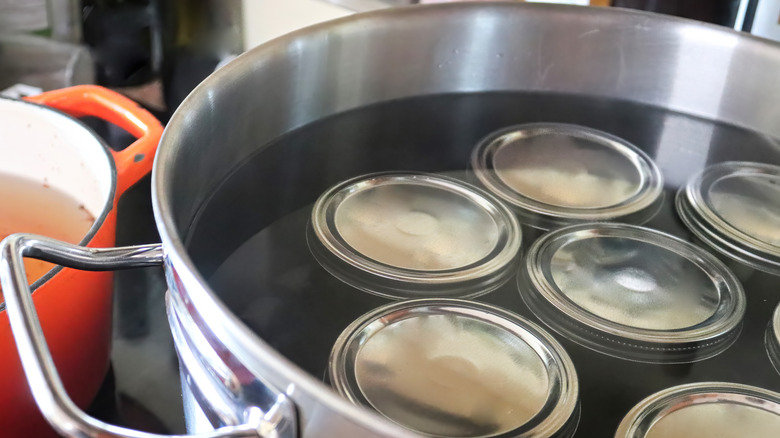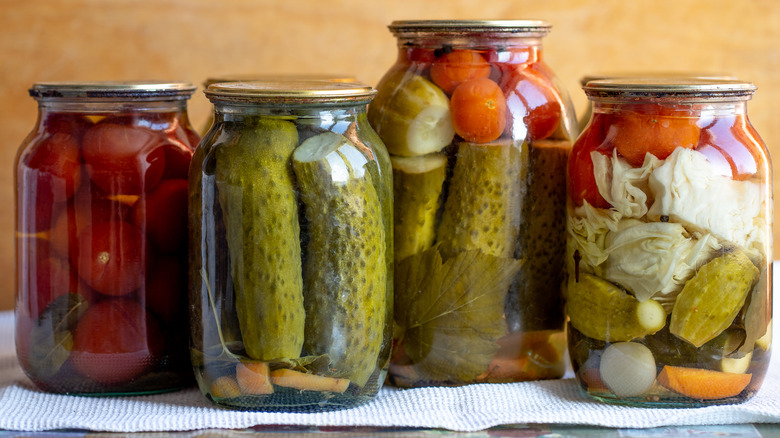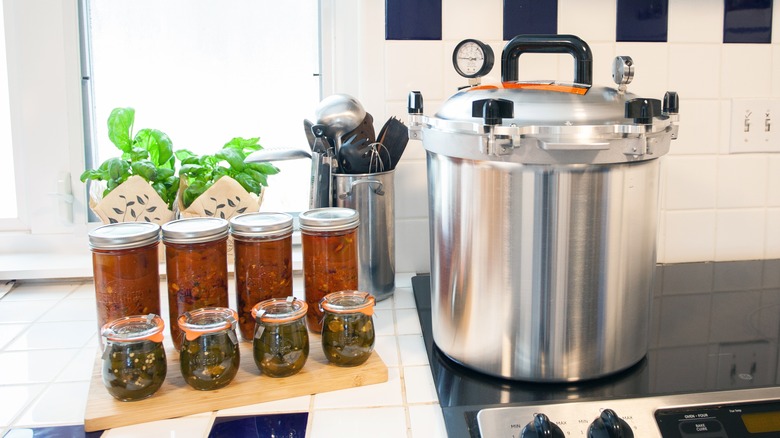The Type Of Food That Should Never Be Canned In Boiling Water
Boiling your jarred foods in a pot of water might be the easiest way to make canned goods, but it isn't always the safest. Certain foods require extra cautionary steps to ensure they remain safe from food-borne pathogens.
According to the National Center for Home Food Preservation, canning foods protects them from spoilage by removing oxygen and eliminating harmful bacteria reproduction. The extra acidity of food like canned tomatoes or pickled vegetables helps prevent spoilage. However, foods that have a lower acidity (pH levels higher than 4.6) are especially vulnerable to bacteria. This means that all they need is a hot water bath to be adequately safe.
Low-acid foods include most raw vegetables, dairy, meat, and seafood products. These can be canned safely, but you'll have to go above and beyond to ensure they retain their quality. The most popular means of preserving these foods include adding acidity and using a device called a pressure canner.
How to add acidity to canned foods
One easy method to add acidity and flavor to canned foods is pickling them. Adding ingredients like vinegar, sugar, and microbial-repelling spices not only helps preserve your foods and their texture but also adds an interesting flavor when you crack them open. Additionally, it allows you to preserve low-acid vegetables and other products without having to invest in specialized equipment.
New Mexico State University says that to pickle these foods for canning, it can be helpful to find a tested recipe to start. Unlike other recipes where it's safe to adjust quantities of different ingredients to suit tastes, it's best to leave these unaltered. This will ensure that you have adequate quantities of preservatives to keep your foods safe during storage.
Once your recipe is assembled and placed in the jar, you should use a rubber spatula to remove as many air bubbles as possible. Then, place a properly sanitized lid on the jar and seal it tight. Use a boiling water bath to completely seal the jar and kill off any bacteria. Once this is complete, verify that your lid is tightly secured by checking that it is completely concave and sealed.
Using a pressure canner
The other method for canning low-acidity foods is to use a pressure canner. This goes a step beyond the standard boiling water by pressurizing the environment, allowing the water to reach higher temperatures. This kills off bacterial spores that may otherwise survive.
It should be noted that pressure canners are not the same as pressure cookers. They are specialized pieces of equipment that are designed for home canning and preservation. While it might be an investment for a hobbyist to obtain a pressure canner, it is the only safe method for preserving unpickled vegetables and animal products.
The National Center for Home Food Preservation says that the process of using a pressure canner isn't much more complicated than boiling water. It simply requires pressurizing the canner, attaching a gauge, and monitoring the temperature and pressure to ensure that the cans are adequately sanitized and sealed. A high-quality pressure cooker might be an expensive purchase for some, but it is the only way to safely can all of your raw veggies for months ahead.


